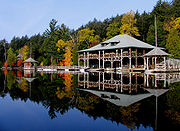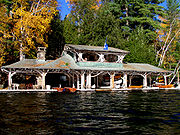
Adirondack Architecture
Encyclopedia



Great Camps
Great camps refer to the grandiose family compounds of cabins that were built in the latter half of the nineteenth century on lakes in the Adirondacks such as Spitfire Lake and Rainbow Lake. The camps were summer homes for the wealthy, where they could relax, host or attend parties, and enjoy the...
within the Adirondack Mountains
Adirondack Mountains
The Adirondack Mountains are a mountain range located in the northeastern part of New York, that runs through Clinton, Essex, Franklin, Fulton, Hamilton, Herkimer, Lewis, Saint Lawrence, Saratoga, Warren, and Washington counties....
area in New York
New York
New York is a state in the Northeastern region of the United States. It is the nation's third most populous state. New York is bordered by New Jersey and Pennsylvania to the south, and by Connecticut, Massachusetts and Vermont to the east...
. The builders of these camps used native building materials and sited their buildings within an irregular wooded landscape. These camps for the wealthy were built to provide a primitive, rustic appearance while avoiding the problems of in-shipping materials from elsewhere.
Elements
Elements such as whole, split, or peeled logs, bark, roots, and burlBurl
A burl or bur or burr is a tree growth in which the grain has grown in a deformed manner. It is commonly found in the form of a rounded outgrowth on a tree trunk or branch that is filled with small knots from dormant buds.A burl results from a tree undergoing some form of stress. It may be caused...
s, along with native granite
Granite
Granite is a common and widely occurring type of intrusive, felsic, igneous rock. Granite usually has a medium- to coarse-grained texture. Occasionally some individual crystals are larger than the groundmass, in which case the texture is known as porphyritic. A granitic rock with a porphyritic...
fieldstone
Fieldstone
Fieldstone is a building construction material. Strictly speaking, it is stone collected from the surface of fields where it occurs naturally...
, were used to build interior and exterior components. Massive fireplace
Fireplace
A fireplace is an architectural structure to contain a fire for heating and, especially historically, for cooking. A fire is contained in a firebox or firepit; a chimney or other flue allows gas and particulate exhaust to escape...
s and chimney
Chimney
A chimney is a structure for venting hot flue gases or smoke from a boiler, stove, furnace or fireplace to the outside atmosphere. Chimneys are typically vertical, or as near as possible to vertical, to ensure that the gases flow smoothly, drawing air into the combustion in what is known as the...
s built of cut stone are also common within the Great Camp architecture. The use of native building materials was not only for promoting a natural appearance, but also to avoid the expense of transporting conventional building materials into a remote location.
Influences
The style drew upon Swiss chaletChalet
A chalet , also called Swiss chalet, is a type of building or house, native to the Alpine region, made of wood, with a heavy, gently sloping roof with wide, well-supported eaves set at right angles to the front of the house.-Definition and origin:...
architecture, which had been introduced to America by Andrew Jackson Downing
Andrew Jackson Downing
Andrew Jackson Downing was an American landscape designer, horticulturalist, and writer, a prominent advocate of the Gothic Revival style in the United States, and editor of The Horticulturist magazine...
around 1850. Log construction was popularized by Downing's protege, Calvert Vaux
Calvert Vaux
Calvert Vaux , was an architect and landscape designer. He is best remembered as the co-designer , of New York's Central Park....
, in his pattern book Villas and Cottages in 1857. Downing's design principles emphasized utility, structural expression, and conformity to natural surroundings. The building form was influenced by Stick style, but using log framing instead of dimensional lumber to express the structural system of the buildings. Charles Eastlake
Charles Eastlake
Charles Locke Eastlake was a British architect and furniture designer. Trained by the architect Philip Hardwick , he popularised William Morris's notions of decorative arts in the Arts and Crafts style, becoming one of the principal exponents of the revived Early English or Modern Gothic style...
's book Hints on Household Taste in Furniture, Upholstery and other Details also influenced the Adirondack rustic style. Interior decorations such as rustic and Mission Style
Arts and Crafts movement
Arts and Crafts was an international design philosophy that originated in England and flourished between 1860 and 1910 , continuing its influence until the 1930s...
furniture, mounted trophies of fish and game, Japanese fans and screens, and American Indian artifacts were influenced by Eastlake's ideas.
Camp Santanoni, Newcomb, New York
Newcomb, New York
Newcomb is a town in Essex County, New York, United States. The population was 481 at the 2000 census.The Town of Newcomb is at the west border of the county. It is southwest of Plattsburgh, southwest of Burlington, VT, northeast of Utica, NY, north-northeast of Albany, NY, and ...
, built for Robert C. Pruyn of Albany, was the first Adirondack camp to be comprehensively designed as a unit by a professional architect, Robert Henderson Robertson
Robert Henderson Robertson
Robert Henderson Robertson was an American architect who designed numerous houses, institutional buildings and churches.-Life and career:...
of New York, who designed the Main Camp Complex.
Style
The Adirondacks buildings were recognized for their rugged finish and outstanding craftsmanship especially by the wealthy locals. The Adirondacks style of architecture can be specialized into custom homes, rugged roofing, log cabins, boat houses, rustic furnishing, rustic kitchen, birch and cedar furniture, log and twig workTwig work
Twig-work is the term applied to architectural details constructed of twigs and branches, usually peeled, to form decorative motifs in buildings and furniture. The most common instances are found in Adirondack Great Camps, in northern New York State, although examples are also found in the...
s.
This style of architecture is found most prominently in and around the area of Adirondack Park.
See also
- Vernacular architectureVernacular architectureVernacular architecture is a term used to categorize methods of construction which use locally available resources and traditions to address local needs and circumstances. Vernacular architecture tends to evolve over time to reflect the environmental, cultural and historical context in which it...
- Great CampsGreat CampsGreat camps refer to the grandiose family compounds of cabins that were built in the latter half of the nineteenth century on lakes in the Adirondacks such as Spitfire Lake and Rainbow Lake. The camps were summer homes for the wealthy, where they could relax, host or attend parties, and enjoy the...
- Sagamore Camp
- Santanoni PreserveSantanoni Preserve-Further readings:* Robert Engel, Howard Kirschenbaum, Paul Malo. Santanoni: From Japanese Temple to Life at an Adirondack Great Camp. Keesville, NY: Adirondack Architectural Heritage, 2000....
- Adirondack Park

